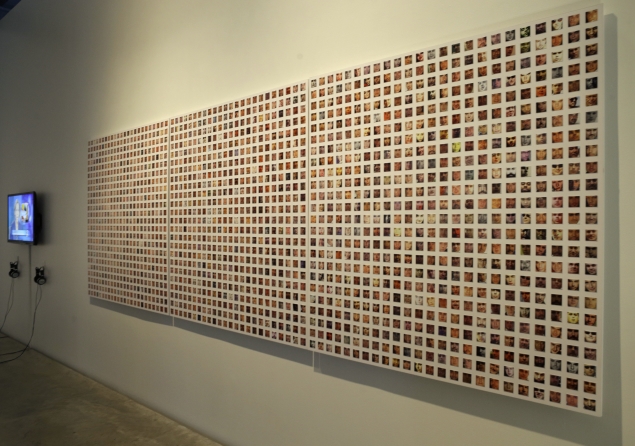- Home
- Internet
- Internet News
- Art restorers' digital challenge: Fixing 1s and 0s
Art restorers' digital challenge: Fixing 1s and 0s

For instance, when a Web-based work becomes technologically obsolete, does updated software simply restore it? Or is the piece fundamentally changed?
That was the conundrum facing the Whitney Museum of American Art, which in 1995 became one of the first institutions to acquire an Internet-made artwork. Created by the artist Douglas Davis, "The World's First Collaborative Sentence" functioned as blog comments do today, allowing users to add to the opening lines. An early example of interactive computer art, the piece attracted 200,000 contributions from 1994 to 2000 from all over the globe.
By 2005 the piece had been shifted between computer servers, and the programmer moved on. When Whitney curators decided to resurrect the piece last year, the art didn't work. Once innovative, "The World's First Collaborative Sentence" now mostly just crashed browsers. The rudimentary code and links were out of date. There was endlessly scrolling and seemingly indecipherable text in a format that had long ago ceased being cutting edge.
"This is not how one uses the Internet now," Sarah Hromack, the Whitney's director of digital media, said. "But in the '90s, it was."
For a generation, institutions from the Museum of Modern Art in New York to the Pompidou Center in Paris have been collecting digital art. But in trying to restore the Davis work, which was finally debugged and reposted at the end of May, the Whitney encountered what many exhibitors, collectors and artists are also discovering: The 1s and 0s of digital art degrade far more rapidly than traditional visual art does, and the demands of upkeep are much higher. Nor is the way forward clear.
"We're working on constantly shifting grounds," said Rudolf Frieling, a curator of media arts at the San Francisco Museum of Modern Art, which has been at the forefront of sustaining online art. "Whatever hardware, platform or device we're using is not going to be there tomorrow."
"Frankly speaking," he added, "it's a huge challenge. Not every museum is set up to do that. It takes huge technical expertise."
The riddles are only solved by "actually doing it," Frieling explained.
At the Whitney, a team of programmers and curators spent more than a year debating and tinkering with the restoration of "Collaborative Sentence." Davis, a pioneer in technologically enhanced art who is now 80, was unable to take part in consultations on rebuilding his piece, and without a creator's blueprint in place, almost every meeting turned into a conceptual debate.
"One of the biggest philosophical questions," said Christiane Paul, adjunct curator of new media at the museum, "was, do we leave these links broken, as a testament to the Web" and its rapid development?
Like much early digital art, "Collaborative Sentence" is still valuable, Paul said, especially as a harbinger of the future. By allowing interaction across cultures and countries, "it anticipated so much of what happened in Web 2.0," she said.
But many artists, curators and patrons are now reconsidering whether such art should remain unchanged, said Pip Laurenson, the head of collection care research at the Tate Gallery in London. "It's no longer the model that a museum acquires something into its collection and tries to fix it into the time it was acquired or when it left the artist's studio."
The Whitney considered several options. One was to simply let technological extinction take its course, and view Web-based art as "ephemeral, like a performance," Paul said.
Another tactic was to let the new generation of Web-based creators and everyday Internet users help with the maintenance. Or the Whitney could attract more viewers by modernizing the design of the piece. But, Paul said, "that seemed too radical an intervention."
After much deliberation, the curators decided on a nearly unheard-of artistic solution: to duplicate Davis' installation and present it in both original and updated forms.
One version is the frozen original, with broken code, pages of oddly formatted, garbled text and instructions for users who wanted to fax in their contributions (including the number for the Lehman College gallery, which first showed the piece). Links were redirected, through the archiving site the Wayback Machine, to their 1990s counterparts.
"The idea is that it's sort of a time capsule," said Ben Fino-Radin, a digital archivist who helped rebuild the work.
The new version, which the Whitney calls the live version, looks similar but has some new links. Users can't contribute to the historical site, but they can add to the live one - albeit not by fax. The Whitney also open-sourced part of the original, hoping that users would contribute to its upkeep.
In 1995 Davis' piece was shown in a biennial in South Korea attended by the celebrated video artist Nam June Paik. It has hundreds of comments in Korean, but the code for the characters was so degraded that Fino-Radin was stumped. If other viewers fix it, he said, seeing those messages "will be a first for Western audiences."
With new digital art being created ever more rapidly, the debate over sustaining it will continue, just as surely as the technology leapfrogs ahead of it. Over the last decade, experts at the New Art Trust, the Tate Modern in London and the Museums of Modern Art in New York and San Francisco started Matters in Media Art, a consortium dedicated to studying these issues. Another group, the Variable Network, was started by the Solomon R. Guggenheim Museum and the Daniel Langlois Foundation for Art, Science and Technology.
Aided by organizations like Rhizome, where Fino-Radin is based and which works with emerging artists and art forms, they have helped spread the word about the urgent need for conservation.
"For institutions that early on committed to Net art, a lot of that work is now vanishing," Paul said.
And the proliferation of online culture, social media and smart gadgets - and whatever the next tech revolution brings - will make preserving those visionary moments "more challenging," she said. "Not less."
© 2013, The New York Times News Service
Get your daily dose of tech news, reviews, and insights, in under 80 characters on Gadgets 360 Turbo. Connect with fellow tech lovers on our Forum. Follow us on X, Facebook, WhatsApp, Threads and Google News for instant updates. Catch all the action on our YouTube channel.
Related Stories
- Samsung Galaxy Unpacked 2025
- ChatGPT
- Redmi Note 14 Pro+
- iPhone 16
- Apple Vision Pro
- Oneplus 12
- OnePlus Nord CE 3 Lite 5G
- iPhone 13
- Xiaomi 14 Pro
- Oppo Find N3
- Tecno Spark Go (2023)
- Realme V30
- Best Phones Under 25000
- Samsung Galaxy S24 Series
- Cryptocurrency
- iQoo 12
- Samsung Galaxy S24 Ultra
- Giottus
- Samsung Galaxy Z Flip 5
- Apple 'Scary Fast'
- Housefull 5
- GoPro Hero 12 Black Review
- Invincible Season 2
- JioGlass
- HD Ready TV
- Laptop Under 50000
- Smartwatch Under 10000
- Latest Mobile Phones
- Compare Phones
- Huawei Nova 15
- Huawei Nova 15 Pro
- Huawei Nova 15 Ultra
- OnePlus 15R
- Realme Narzo 90x 5G
- Realme Narzo 90 5G
- Vivo S50 Pro Mini
- Vivo S50
- Asus ProArt P16
- MacBook Pro 14-inch (M5, 2025)
- Huawei MatePad 11.5 (2026)
- OnePlus Pad Go 2 (5G)
- Huawei Watch 10th Anniversary Edition
- OnePlus Watch Lite
- Acerpure Nitro Z Series 100-inch QLED TV
- Samsung 43 Inch LED Ultra HD (4K) Smart TV (UA43UE81AFULXL)
- Asus ROG Ally
- Nintendo Switch Lite
- Haier 1.6 Ton 5 Star Inverter Split AC (HSU19G-MZAID5BN-INV)
- Haier 1.6 Ton 5 Star Inverter Split AC (HSU19G-MZAIM5BN-INV)

















